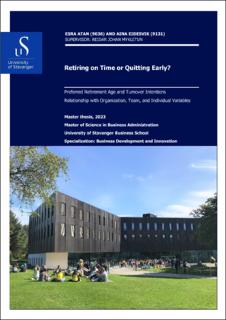| dc.description.abstract | This thesis aims to investigate the dependent variables of preferred retirement age and turnover intentions. The relevance of retirement age in Norway stems from the country's aging population and the projected future workforce shortage. Turnover intentions refer to an individual's desire to leave their current job in the near future. The thesis focuses on identifying the independent variables that predict preferred retirement age and turnover intentions. To achieve this, a model was developed, categorizing the variables into three dimensions: Organizational, Team, and Individual levels.
The analysis utilizes a dataset collected from 1531 participants, which is considered representative of the Norwegian workforce. The data's reliability and validity have been
established through prior research, and our factor and reliability analysis further confirmed this. To examine the relationship between the dependent and independent variables, bivariate correlation and multiple hierarchical regression analyses were conducted. The results revealed a strong negative correlation between turnover intentions and preferred retirement age, indicating that individuals with a higher preferred retirement age exhibit fewer turnover intentions.
In the analysis of preferred retirement age, the correlation analysis indicated a strong relationship between certain individual variables and an increase in retirement age. Specifically, supportive leadership, autonomy, cognitive demands, social support, and age were confirmed as significant predictors of higher retirement age. In the multiple regression analysis, all these variables were found to be significant in step 1, except for autonomy in working methods and social support (which were not included in the model). However, in step two, all variables lost their significance. Consequently, these hypotheses are considered partially supported.
When examining turnover intentions, the correlation analysis revealed a robust association among various independent variables. Specifically, emotional demands, quantitative demands, learning demands, age discrimination, negative acts, exhaustion, mental distance, emotional impairment, and cognitive impairment were all identified as significant predictors of increased turnover intentions. In the subsequent multiple regression analysis, quantitative demands, negative acts, exhaustion, mental distance, and health remained significant in step 3. Conversely, we identified autonomy in working methods and working time, supportive leadership, social support, and age as significant predictors of lower turnover intentions. These variables exhibited a strong negative correlation and maintained their significance in step 3 of the multiple regression analysis. | |
